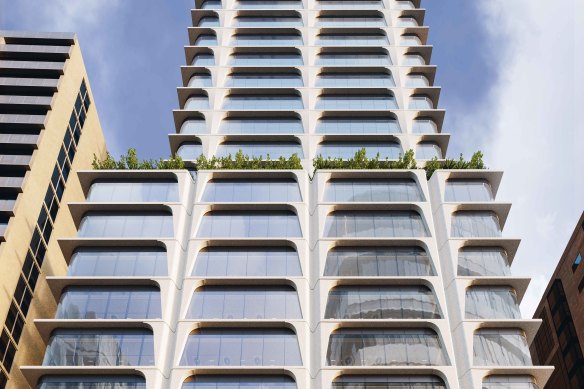
Time & Place director Tim Price said the plan reflected “market demand, particularly among affluent private firms and family-run businesses who are opting to invest rather than lease”.
“These investors are seeking assets rich in historical and societal value,” Price said.

Cheaper to buy than rent: Golden Age is counting on downsizing professional firms that want to own a piece of the city.Credit:
Research from Colliers shows owner-occupiers are dominating the market, making up 67 per cent of all strata buyers in 2023 and 71 per cent of buyers in the first quarter of 2024.
Golden Age’s almost completed tower at 130 Little Collins Street, the first purpose-built strata tower in Melbourne’s CBD since 41X on Exhibition Street in 2014, is about 80 per cent sold, with prices holding at around $18,000 per square metre.
Restaurateur Chris Lucas splashed $13 million on two levels for the Lucas Group’s head office, and another buyer recently paid $2.89 million for a half-floor office.
Loading
But most strata development is in inner-city suburbs, where owner-occupiers are keen to buy new offices closer to where they live.
Other notable recent deals include a Sydney-based buyer snapping up Vicland’s old head office – the penthouse at 529 Chapel Street, South Yarra – for $5 million.
Cushman & Wakefield agent George Davies, who did the deal with Oliver Hay and Anthony Kirwan, said most interested parties were high-net-worth family offices looking for local space.
Cushman & Wakefield have achieved prices of around $15,000 per square metre at Alterra at 70-72 Cubitt Street, Cremorne, and $12,500 to $15,000 per square metre at Emerald Place in South Melbourne.
Loading
Davies said buyers are seeking wealth creation, flexibility and control.
Mike Williams said his development created a post-COVID “club-like” workplace where people could feel at home in their office, but also use elegant communal areas to mingle.
“We have modelled Merchant off 350 George Street, but we have added many more shared facilities for occupiers, as well as balconies.”
Merchant’s now completed strata offices each have their own bathroom with shower, a galley bar, and individual air-conditioning units. Some have sofa beds.
To add to the hotel feel, there’s a concierge service and towel service, an ice machine on each floor, and a floor dedicated to meeting rooms, a wine cellar, a library, a lounge area for guests, and a bike room and lockers.
Prue Williams said there had been steady interest from company directors, legal professionals, and the property industry itself, particularly due to its location.
“W have now sold 60 per cent of the offices, with more contracts imminent, and as the space starts to take shape through construction we have seen interest significantly increase,” she said.
Space in Merchant is being marketed for sale by Andrew Harford and Jessen O’Sullivan of Knight Frank, with Tim Noonan and Ben Kennedy of Noonan Property.
Buyers include barrister Peter Skinner, who will make Merchant his base, as will Debra Singh, a director on ASX-listed boards.
Loading
Harford said W Property’s track record of successful adaptive re-use strata projects in the CBD, Pyrmont and Surry Hills “helped to get a number of offices pre-sold before completion”.
“Given the wider market and economic conditions, the sales milestone for Merchant is impressive and testament to how well this project has been received by buyers,” he said.
“Merchant is offering a unique product that is a first for the strata market in Sydney, being a hybrid between conventional offices and a lifestyle offering.”
Harford added that the project has also filled a gap in the market left by the compulsory acquisition by the NSW government of 11 CBD buildings for the Sydney Metro Western line, which displaced many owner-occupiers.
Typical suites in Merchant were selling for just over $1 million or around $23,000 per square metre, but suites with larger balconies were selling for up to $28,000 per square metre.
Prue Williams said Merchant’s design and unique offering reflected changing demands from occupiers in the office space.
“This is the way offices are going; they are much more lifestyle-driven than corporate-driven,” she said.
Williams added that the group wanted to emulate Melbourne’s laneway culture.
“We got permission from the co-owners of 90 Pitt Street to paint a large eight-storey artwork on the rear of their building,” she said.
The group engaged street artist Fintan Magee, who painted a floral wall dominating the western end of the laneway and an eight-storey portrait of Hosking on Merchant’s western wall.
The Business Briefing newsletter delivers major stories, exclusive coverage and expert opinion. Sign up to get it every weekday morning.



























